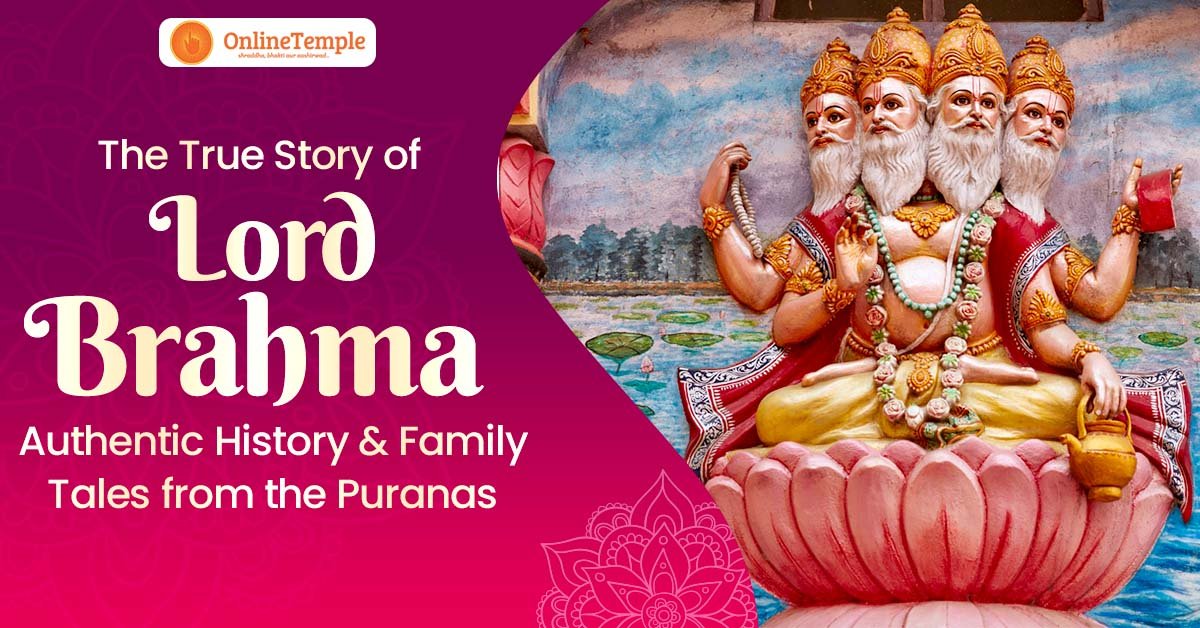Lord Brahma, a significant god in Hinduism, is known as the creator and the father of the Vedas. According to Puranic stories, Brahma created the universe and beings like gods, demons, ancestors, and humans. His wife, Saraswati, gave birth to important things like the Vedas and knowledge. Brahma has sons like Daksa, Seven Sages, and Prajapati. Even though he played a massive role in making everything, people don’t worship Brahma much, and there are only a few temples for him. The Puranas tell interesting stories about Brahma and his family, adding colour to the rich tales of Hindu mythology. Moreover, if you are looking for an online puja website, must visit Onlinetemple. We have a plethora of puja services.
Lord Brahma and the Vedas
Lord Brahma is hailed as the creator of the Earth and all beings in Hinduism. The Vedas, ancient and sacred Hindu scriptures, are attributed to him, establishing Brahma as the father of dharma. It is important not to confuse him with Brahman, the general term for the Supreme Being. Despite being part of the Trinity, Brahma’s popularity doesn’t match that of Vishnu and Shiva, and he is more present in scriptures than in homes and temples.
Birth of Lord Brahma
In the Puranas, the description of Lord Brahma portrays him as the son of God, frequently identifying him as the head of the divine beings. According to the Shatapatha Brahman, Brahma was born from the Supreme Being Brahman and the feminine energy known as Maya. To create the universe, Brahman first made water, planting his seed within it, which transformed into a golden egg, giving rise to Brahma.
Another legend tells of Brahma being self-born from a lotus flower that grew from Vishnu’s navel. To assist in creating the universe, Brahma gave birth to the eleven forefathers known as “Prajapatis” and the seven great sages or the “Saptarishi,” referred to as the “Manasputras,” born from his mind.
Cosmic Creation and Divine Design
As Brahma emerged from the cosmic golden egg, he created good and evil, light and dark, and the four types: gods, demons, ancestors, and men. Brahma’s process of creation involved abandoning his body multiple times, resulting in the formation of Night, Day, Dusk, and Dawn. This cycle repeats in every aeon, with Brahma appointing Shiva to rule over humanity in some myths.
Creation of Women and Preventing Power
To prevent men from becoming too powerful and challenging the gods, Brahma created wanton women. These sensual women stirred up men with their desires, introducing anger as a companion to desire. This myth explains the origin of human attachment to women, according to Hindu beliefs.
Symbolism and Depictions of Brahma
Lord Brahma, often depicted with four heads, represents the four Vedas, the four yugas (epochs of time), and the four varnas (social classes). His hands hold symbolic objects, emphasizing knowledge, time, and the tools of sacrifices. Temples dedicated to Brahma portray him in various postures and with different implements, showcasing his multifaceted nature.
The Chaturmukha Brahma
Originally having five heads, one was later blocked by Shiva in a fit of fury, resulting in the iconic Chaturmukha Brahma with four heads. These heads represent the four Vedas, four Yugas, and the four Varnas. Each face has a beard, closed eyes in meditation, and hands holding different objects symbolizing time, water, and knowledge.
Rituals and Worship
Devotion to Lord Brahma involves unique rituals, with the Brahma Temple in Pushkar being a notable pilgrimage site. Followers perform Online booking for special pujas, offering flowers and fruits, and may observe fasts on special days. While not as common as worship of other deities, devotees find solace in these distinctive practices, seeking creative guidance and knowledge through meditation and mantra recitation.
Concluding Statement:
In the vivid tales of Hinduism, Lord Brahma emerges as the prime creator, intricately sculpting and reshaping existence in an eternal cosmic dance. Although not extensively worshipped, his narratives of creation and cosmic cycles paint a vibrant canvas in the diverse hues of Indian spirituality, infusing a distinct essence into the sagas of divine beings. Make your pooja (prayer) rituals easy and convenient by buying puja samagri online. Elevate your spiritual experience with just a click!
Also Read: The Ten Sons of Lord Brahma: The Prajapatis

